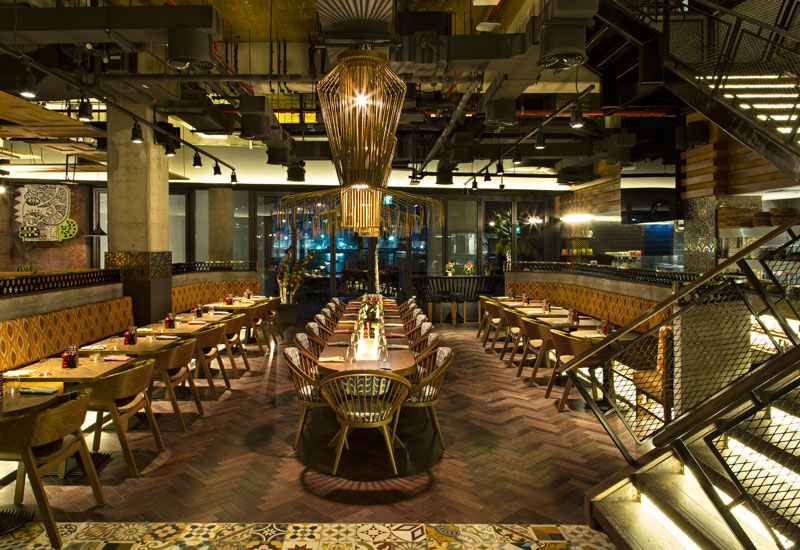HOW DO MID-MARKET HOTEL REFURBISHMENTS DIFFER FROM LUXURY MARKET ONES?
RACHAEL BROWN: The target audience of the hotel is the main difference for us and is therefore our key focus. Guests of a mid-market hotel are likely to have a different approach to travel than those looking for a luxury hotel stay, and we believe the art package should reflect that. In today’s market, the artwork for mid-market hotels is focused on the mind-set of their guests, which is why the artwork tends to be fresh and engaging for the no-frills traveller.
DIMITRI PAPAKONSTANTINOU: The obvious difference is the square metre cost of materials and the general specification. With mid-market hotels, the client will want to retain as much as possible from the original construction as opposed to stripping everything back to shell and core.

| Advertisement |
WHAT ARE SOME OF THE CHALLENGES OF REFURBISHING A MID-MARKET PROPERTY?
RACHAEL BROWN: Budgets and timelines are always a big challenge to us, as often artwork and accessories are considered towards the end of the project and inevitably both aspects are constrained at this time. We encourage our clients to discuss both aspects openly with us as realistic expectations help us be as effective as possible to both ends. We also find that often an art package can be extensive yet the multiple small scale artworks specified make little impact for a high cost, whereas we often suggest to have a few key artworks that make a real impact in the interiors and give more value for money.
PAPAKONSTANTINOU: The challenge with these projects, and honestly many other construction projects in the UAE, is the client defining a clear scope and budget to the design team so as to avoid the cost being so far off the client’s budget. This usually leads to a design which needs to be further value engineered or drastically changed to reduce the cost. The other obvious challenges are that most construction materials are imported and not locally available hence cost and timeline are very much dependant on strategic and timely procurement.
ARE THERE SUPPLIERS YOU WORK WITH THAT ARE SPECIFIC TO THE MID-RANGE MARKET?
RACHAEL BROWN: It’s less about using a specific supplier for mid-range and more about the approach you have in regards to materials, design, and scale.
PAPAKONSTANTINOU: There are several suppliers across many regions that can provide mid-range products, we don’t have affiliations with specific suppliers but rather engage with them as per the project requirements.
WHAT ARE SOME REFURBISHMENT TRENDS THAT YOU ARE SEEING IN THE MID-RANGE MARKET?
RACHAEL BROWN: With new mid-market hotels opening in the region, it’s not just refurbishment of existing properties we’re seeing, but of the hotel brands themselves and the way they communicate with their guests. This has meant that we’re seeing a real emphasis on using art to engage with guests and connect them to the city and culture of the region in exciting ways. We’re also seeing a difference in the way spaces are created, with more communal areas provided for guests to mingle and work.
PAPAKONSTANTINOU: I believe it is still relatively early as far as refurbishments of mid-range hotels go. I believe there will be an influx of refurbishments in the next few years in the lead-up to 2020. Most hotels in Dubai and sometimes the UAE are still fairly ‘luxurious’ in relation to other countries despite being mid-range. I trust they will want to keep this trend.
WHAT ADVICE WOULD YOU OFFER A MID-MARKET HOTELIER WHO IS CONSIDERING A REFURB FOR HIS/HER PROPERTY?
RACHAEL BROWN: Don’t be afraid of art — it’s a great way to bring fresh life to a property. There are creative ways to produce impactful art that will bring added value to your property and brand experience in simple and low cost ways.
PAPAKONSTANTINOU: I would advise clients to work closely with their design team and possibly engage early with a contractor so as to maintain their budget. This will avoid unnecessary delays in the start and completion of the works. Furthermore I would strongly suggest that a detailed survey of the existing services, structure etc is done as far as possible before the works start so as to avoid removing services that may still be functional, and avoid delays during the construction whereby the contractor has to stop/start works to get clear direction.










 Search our database of more than 2,700 industry companies
Search our database of more than 2,700 industry companies









